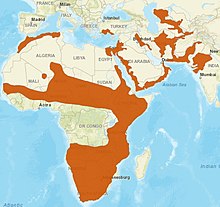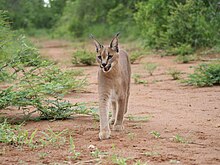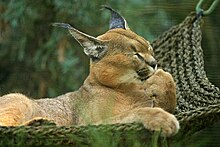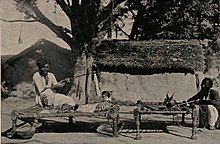Caracal
| Caracal | |
|---|---|

| |
| Caracal in Kgalagadi Transfrontier Park | |
| Scientific classification | |
| Domain: | Eukaryota |
| Kingdom: | Animalia |
| Phylum: | Chordata |
| Class: | Mammalia |
| Order: | Carnivora |
| Suborder: | Feliformia |
| Family: | Felidae |
| Subfamily: | Felinae |
| Genus: | Caracal |
| Species: | C. caracal
|
| Binomial name | |
| Caracal caracal (Schreber, 1776)
| |
| Subspecies | |
|
See text | |

| |
| Distribution of caracal, 2016[1] | |
| Synonyms | |
|
List
| |
The caracal (Caracal caracal) (
Typically
Etymology
The name 'caracal' was proposed by Georges Buffon in 1761 who referred to its Turkish name 'Karrah-kulak' or 'Kara-coulac', meaning 'black ear'.[3][4] The 'lynx' of the Greeks and Romans was most probably the caracal, and the name 'lynx' is sometimes still applied to it, but the present-day lynx proper is a separate genus.[5]
The caracal is also known as desert lynx and Persian lynx.[6]
Local names
Its name in the Tigrinya language is ጭክ ኣንበሳ, ch’ok anbessa, which means 'bearded lion'.[7] In the
Taxonomy and phylogeny
Felis caracal was the
In the 19th and 20th centuries, several caracal specimens were described and proposed as subspecies. Since 2017, three subspecies have been recognised as valid:[11]
- Southern caracal (C. c. caracal) (Schreber, 1776) – occurs in Southern and East Africa
- Northern caracal (C. c. nubicus) (Fischer, 1829)[12] – occurs in North and West Africa
- Asiatic caracal (C. c. schmitzi) (Matschie, 1912)[13] – occurs in Asia
Phylogeny
Results of a
The relationship of the caracal is considered as follows:[14][15]
| |||||||||||||||||||||||||||||||||||||||||||
Characteristics

The caracal is a slender, moderately sized cat characterised by a robust build, a short face, long
The prominent facial features include the 4.5-cm-long black tufts on the ears, two black stripes from the forehead to the nose, the black outline of the mouth, the distinctive black facial markings, and the white patches surrounding the eyes and the mouth. The eyes appear to be narrowly open due to the lowered upper eyelid, probably an adaptation to shield the eyes from the sun's glare. The ear tufts may start drooping as the animal ages. The coat is uniformly reddish tan or sandy, though black caracals are also known. The underbelly and the insides of the legs are lighter, often with small reddish markings.[19] The fur, soft, short, and dense, grows coarser in the summer. The ground hairs (the basal layer of hair covering the coat) are denser in winter than in summer. The length of the guard hairs (the hair extending above the ground hairs) can be up to 3 cm (1.2 in) long in winter, but shorten to 2 cm (0.8 in) in summer.[20] These features indicate the onset of moulting in the hot season, typically in October and November.[21] The hind legs are longer than the forelegs, so the body appears to be sloping downward from the rump.[18][19]
Male caracals measure in head-to-body length 78–108 cm (31–43 in) and have 21–34 cm (8.3–13.4 in) long tails; 77 male caracals ranged in weight between 7.2 and 19 kg (16 and 42 lb). The head-to-body length of females is 71–103 cm (28–41 in) with a tail of 18–31.5 cm (7.1–12.4 in); 63 females ranged in weight between 7 and 15.9 kg (15 and 35 lb).[22]
The caracal is often confused with a lynx, as both cats have tufted ears. However, a notable point of difference between the two is that Lynx species are spotted and blotched, while the caracal shows no such markings on the coat.
The skull of the caracal is high and rounded, featuring large
Distribution and habitat

In Africa, the caracal is widely distributed south of the
In
In the Emirate of Abu Dhabi, a male caracal was photographed by camera traps in Jebel Hafeet National Park in Al Ain Region, in spring 2019, the first such record since the mid-1980s.[25]
In south-western Turkey, caracals are present in a wildlife reserve in the provinces of Antalya and Muğla that is regularly used for recreational and agricultural activities.[26] However, they avoid humans and are active mostly at night.[27] In Uzbekistan, caracals were recorded only in the desert regions of the Ustyurt Plateau and Kyzylkum Desert. Between 2000 and 2017, 15 individuals were sighted alive, and at least 11 were killed by herders.[28]
In Iran, the caracal has been recorded in Abbasabad Naein Reserve, Bahram’gur Protected Area,
In India, the caracal occurs in
Ecology and behaviour

The caracal is typically
Diet and hunting

A carnivore, the caracal typically preys upon small mammals and birds. In South Africa, it preys on the Cape grysbok, common duiker, bush vlei rats, rock hyrax and Cape hare.[38][39][40] Mammals generally comprise at least 80% of its diet, and it may also target larger antelopes such as young kudu, impala, Cape bushbuck, mountain reedbuck and springbok.[20] The remaining percentage is made up of lizards, snakes and insects.[1] Rodents comprise a significant portion of its diet in western India.[34] It feeds on a variety of sources, but tend to focus on the most abundant one.[41] In South Africa, caracals have been documented preying on small livestock in areas where sheep and goat are farmed. Livestock is however only a small and seasonal portion of their diet when wild prey is scarce.[38][22] Occasionally, it consumes grasses and grapes, which help to clear the immune system and stomach of any parasites.[42]
The caracals's speed and agility make it an efficient hunter, able to take down prey two to three times its size.
Reproduction

Both sexes become
In the 1990s, a captive caracal spontaneously mated with a domestic
Threats
The caracal is listed as
Conservation

African caracal populations are listed under
In South Africa, the caracal is considered Least Concern, as it is widespread and adaptable to a variety of habitats. It is tolerant to human-dominated areas, although it has been persecuted for many decades. Farmers are encouraged to report sightings of caracals, both dead and alive, and livestock killed by caracals to the national Predation Management Information Centre.[47]
The Central Asian caracal population is listed as Critically Endangered in Uzbekistan since 2009, and in Kazakhstan since 2010.[28][48][49]
In culture

The caracal appears to have been religiously significant in the ancient Egyptian culture, as it occurs in paintings and as bronze figurines; sculptures are thought to have guarded the tombs of pharaohs.[51] Embalmed caracals have also been discovered.[52]
The caracal was esteemed for its ability to catch birds in flight and was used for
Caracals were captured, bred, and tamed in
References
- ^ . Retrieved 15 January 2022.
- ^ OCLC 62265494.
- ^ Buffon, G.-L. L. (1761). "Le Caracal". Histoire naturelle, générale et particulière, avec la description du Cabinet du Roi. Vol. IX. Paris: L'Imprimerie Royale. pp. 262–267.
- ^ "Caracal". Merriam-Webster.com Dictionary. Retrieved 18 February 2016.
- ^ Baynes, T. S., ed. (1878). . Encyclopædia Britannica. Vol. V (9th ed.). New York: Charles Scribner's Sons. pp. 80–81.
- ISBN 978-1-61530-340-3.
- ^ ISBN 978-3-030-04954-6.
- ^ Connect with Nature UAE (10 March 2019). "Caracal - A Cat That Barks". Retrieved 7 May 2021.
- ^ Schreber, J. C. D. (1777). "Der Karakal". Die Säugethiere in Abbildungen nach der Natur mit Beschreibungen. Erlangen: Wolfgang Walther. pp. 413–414.
- ^ Gray, J. E. (1843). "The Caracal". List of the specimens of Mammalia in the collection of the British Museum. London: The Trustees of the British Museum. p. 46.
- ^ Kitchener, A. C.; Breitenmoser-Würsten, C.; Eizirik, E.; Gentry, A.; Werdelin, L.; Wilting, A.; Yamaguchi, N.; Abramov, A. V.; Christiansen, P.; Driscoll, C.; Duckworth, J. W.; Johnson, W.; Luo, S.-J.; Meijaard, E.; O’Donoghue, P.; Sanderson, J.; Seymour, K.; Bruford, M.; Groves, C.; Hoffmann, M.; Nowell, K.; Timmons, Z. & Tobe, S. (2017). "A revised taxonomy of the Felidae: The final report of the Cat Classification Task Force of the IUCN Cat Specialist Group" (PDF). Cat News (Special Issue 11): 62−63.
- ^ Fischer, J. B. (1829). "F. caracal Schreb.". Synopsis Mammalium. Stuttgart: J. G. Cottae. p. 210.
- ^ Matschie, P. (1912). "Über einige Rassen des Steppenluchses Felis (Caracal) caracal (St. Müll.)". Sitzungsberichte der Gesellschaft Naturforschender Freunde zu Berlin. 1912 (2a): 55–67.
- ^ S2CID 41672825.
- ^ ISBN 978-0-19-923445-5.
- S2CID 40185850.
- ISBN 978-0-8018-5789-8.
- ^ ISBN 978-0520-080-850.
- ^ ISBN 978-0-226-77999-7.
- ^ ISBN 978-1472-912-367.
- ^ ISBN 978-1107-340-992.
- ^ ISBN 9781408189962.
- ISBN 978-0864-861-320.
- ^ ISBN 90-04-08876-8.
- .
- ^ "Nesli tükenme tehlikesi altındaki karakulak Muğla'da görüldü". sozcu.com.tr. Sözcü. 22 January 2023.
- S2CID 209339807.
- ^ .
- S2CID 84982794.
- ^ Farhadinia, M. S.; Akbari, H.; Beheshti, M.; Sadeghi, A. & Halvani, M. R. (2008). "Felids of the Abbasabad Naein Reserve, Iran". Cat News (48): 14–16.
- ^ Ghoddousi, A.; Ghadirian, T. & Fahimi, H. (2009). "Status of caracal in Bahram'gur Protected Area, Iran". Cat News (50): 10–13.
- ^ Mousavi, M. (2010). "Survey of Caracal caracal in Kavir National Park in Iran". Journal of Environmental Research and Development. 4 (3): 793–795.
- ^ Akbari, H.; Azizi, M.; Poor Chitsaz, A. & Nooranian, S. R. (2016). "Distribution, abundance and activity pattern of caracal (Caracal caracal) in Yazd, Iran". Experimental Animal Biology. 15: 71–78.
- ^ doi:10.1017/S0952836903004783. Archived from the original(PDF) on 11 August 2017. Retrieved 29 March 2020.
- .
- ^ .
- .
- ^ a b c Stuart, C.T. & Hickman, G. C. (1991). "Prey of caracal (Felis caracal) in two areas of Cape Province, South Africa". Journal of African Zoology. 105 (5): 373–381.
- ^ Palmer, R. & Fairall, N. (1988). "Caracal and African wild cat diet in the Karoo National Park and the implications thereof for hyrax" (PDF). South African Journal of Wildlife Research. 18 (1): 30–34.
- .
- .
- ^ Bothma, J. D. P. (1965). "Random observations on the food habits of certain Carnivora (Mammalia) in southern Africa". Fauna and Flora. 16: 16–22.
- PMID 21320626.
- ^ ISBN 978-0226-780-269.
- .
- ^ Kusminych, I. & Pawlowa, A. (1998). "Ein Bastard von Karakal und Hauskatze im Moskauer Zoo". Der Zoologische Garten. 68 (4): 259–260.
- ^ Avenant, N.; Drouilly, M.; Power, R.; Thorn, M.; Martins, Q.; Neils, A.; Plessis, J. & Do Linh San, E. (2016). "A conservation assessment of Caracal caracal". In Child, M. F.; Roxburgh, L.; Do Linh San, E.; Raimondo, D. & Davies-Mostert, H. T. (eds.). The Red List of Mammals of South Africa, Lesotho and Swaziland. South Africa: South African National Biodiversity Institute and Endangered Wildlife Trust. pp. 1–13.
- ^ Abdunazarov, B. B. (2009). "Turkmenskiy karakal Caracal caracal (Schreber, 1776) ssp. michaelis (Heptner, 1945) [Turkmen Caracal Caracal caracal (Schreber, 1776) ssp. michaelis (Heptner, 1945)]". Krasnaya kniga Respubliki Uzbekistan. Chast' II Zhivotnye [The Red Data Book of the Republic of Uzbekistan. Part II, Animals]. Tashkent: Chinor ENK. pp. 192–193.
- ^ Bekenov, A. B. & Kasabekov, B. B. (2010). "Karakal Lynx caracal Schreber, 1776". Krasnaya kniga Respubliki Kazakhstan. Tom 1, Zhivotnye. Chast' 1 Pozvonochnye [The Red Data Book of the Republic of Kazakhstan, Vol. 1, Animals. Part 1, Vertebrates]. Almaty: Ministerstvo obrazovaniya i nauki Respubliki Kazakhstan [Ministry for Education and Science of the Republic of Kazakhstan]. pp. 256–257.
- ^ Boeck, K. (1900). Indische Wunderwelt. Reisen und Erlebnisse in Britisch-Indien und auf Ceylon [Indian wonder world. Travels and experiences in British India and Ceylon]. Leipzig: H. Hässel.
- ^ Malek, J. (1997). The cat in ancient Egypt (Revised ed.). Pennsylvania: University of Pennsylvania Press.
- S2CID 84308532.
- ISBN 978-0-8248-2884-4.
- .
Notes
- ^ Only populations of Asia. All other populations are included in Appendix II.
External links
- "Caracal". IUCN Cat Specialist Group.
- Caracal Project
- Cats for Africa: Caracal Distribution
- "Arabian caracal spotted for first time in Abu Dhabi in 35 years". The National. Abu Dhabi. 24 February 2019 [February 23, 2019]. Retrieved 23 February 2019.

